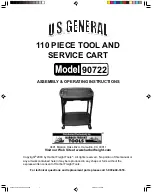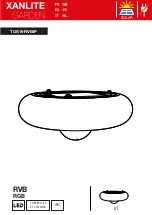
14
15
moves, walk around and correct it again.
4. Inspect the harness, reserve, speed system and all connections.
Final preflight check
1. Strap into the harness. The leg straps should be the first to
be connected on the take-off and the last ones to be released
after the flight. Make sure you are strapped in correctly and
wearing a helmet.
2. Check the risers for a twist and that the carabiners are properly
closed. Check if the speed system is not affecting your risers
– accelerating unintentionally.
3. Check the lines. The A riser lines should be on top, and all
lines untangled. Check if none of the lines are lying over or
below the canopy.
4. Check the canopy. The glider should be spread out in the
shape of an arch and all cells open.
5. Check the wind, take-off and airspace. The wind should
be favourable for take-off and the pilot’s level of expertise.
Airspace should be cleared, together with the take-off area.
Inflation, control, take-off
The PAWN has easy take-off behavior and does not require any
additional advice regarding the forward or reverse launch. Try to
divide and practice the take-off procedure in three steps.
1. Inflating and raising the glider
2. Controlling the wing and wing check
3. Accelerating and take-off
It is always advisable to practice and improve proper launching
techniques as this reduces unnecessary additional stress before
the take-off.
Wind speeds up to 25 to 30km/h are considered strong and extra
care is required for the flight. If you are launching in strong winds
we recommend the reverse launch technique, with your brakes
in the right hands at all times. Launch the glider with a gentle pull
and then walk towards it if necessary to reduce the relative wind
force. When the glider is above you, gently control the wing and
take off.
Line knots or tangles
If you fail to observe a line knot or you find yourself flying with a
knot before being able to prevent the unintentional, uncontrolled
take-off, try to stay away from the ground or other pilots by flying
away from the mountain, before taking any corrective action on
the wing. This means that you weight shift and/or counter brake
the opposite side of the wing and control the flying direction with
the least amount of force needed for the wing to fly straight away
from the mountain. Be careful not to apply too much brake or
to fly too slowly to avoid a stall or spin. When you are at a safe
distance away from the mountain and you have gained relative
height by flying away, you may want to gently and briefly pull the
lines that are tangled with the knot. If the knot is on the brake lines
you might want to gently and briefly “pump” the appropriate brake
line. Please note that by pulling the lines, the knot may get stuck
in a worse position and the situation may escalate also to a stall
or spin. Therefore, if you estimate that you can control the wing
relatively safely and that the knot is not released by gently and
briefly pulling the tangled lines, immediately fly to the landing
zone and land safely.
Normal flight, best glide
Without any brakes applied and without using the accelerator,
the wing flies at the so called “trim speed“. In calm air this is
theoretically the best glide speed. The best speed glide depends
on the glider’s polar and air mass, vertical and horizontal speed.
We recommend reading more about the theory of the best glide
and McCready theory.
Minimum sink
If you apply brakes on both sides for about 15 to 20cm you will
slow the glider to the theoretical minimum sink speed. But we
do not recommend using this speed even for thermalling, as you
achieve much better climbing and control by letting the glider fly
with its “trim speed” and natural energy. With a proper take-off
weight you will find that the glider has great climb, reactions and
agility.
Accelerated flight
After you get comfortable flying the PAWN, you can start practicing
using the speed system, which will provide better performance
while gliding against the wind and through a sinking air mass. The
PAWN was designed to be stable through its entire speed range,
but this requires the use of active flying techniques. Note that any
glider becomes less stable while flying accelerated and that the
risk of a collapse is higher in accelerated flight. Additionally, the
reaction of the glider to a collapse in accelerated flight is more
radical in comparison to the one which occurs at trim speed.
We recommend that you avoid accelerated flight near the ground
and to be very careful using the accelerator in turbulent conditions.
Use a soft speed bar, which enables you to accelerate the glider
by using only one leg. To control the direction use weight shift.
To control the pitch change the amount of the speed bar. Do not
use or pull the brakes while using the speed bar. Use the speed
bar progressively when accelerating and instantly release when
you feel a slight loss of tension, pressure or even a collapse. If you
encounter a collapse while using the accelerator, release the speed
bar immediately before taking any other corrective action. Always
keep more distance from the ground when using the speed bar.
Active flying
This is a basic flying technique for any pilot. It implies permanent
control and the correction of pitch and roll movements together
with the prevention of any deflations or collapses. In a nutshell this
means flying straight through active or turbulent air, so that the pilot
keeps the glider above his or her head at all times, compensating
and correcting any unwanted movements of the wing.
Few examples:
• While entering a strong thermal, the wing will stay a little bit
behind relative to the pilot. The pilot should let the brake up
allowing the wing to fly faster and to catch up.
• If the wing surges in front of the pilot, the pilot should counter
brake until the surge is controlled and then release the glider
to let it fly normally.
Summary of Contents for PAWN
Page 1: ......
Page 2: ...USER MANUAL Version 1 0 Date 10 05 2013 Beginner of The Game EN LTF A...
Page 16: ...30 31...
Page 20: ......






































